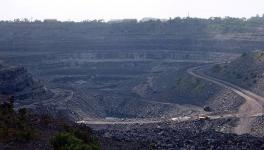Modi Govt Allows Commercial Mining in Captive Blocks Even in Reserved Forests
Representational Image. Image Courtesy: Wikimedia Commons
New Delhi: In what could have far-reaching implications for the environment and livelihoods of communities living near forested areas of the country, the Narendra Modi government has allowed commercial mining from captive blocks even within reserve forests.
In a circular dated March 17, the Central government has asked state governments to allow lease holders of captive mines within reserved forests to sell up to 50% of total minerals extracted in a year after meeting end-use restrictions.
The circular was issued by the Union Ministry of Environment, Forests & Climate Change (MoEF&CC), based on recommendations made to it by the Forest Advisory Committee (FAC), an expert body that advises the Central government on matters pertaining to diversion of reserved forest areas for the purpose of establishing industries.
Through the circular, the Central government has, in a post facto manner, declared “null and void” all restrictions that have been put on place upon commercial sale of minerals from captive mining blocks in reserve forests.
“Based on the recommendation of the Advisory Committee [FAC] and approval of the same by the competent authority of the MoEF&CC, New Delhi, the Central Government hereby clarifies that in pursuance to the provisions of the Mines and Minerals (Development and Regulations) Amendment Act, 2021 and rules framed, the condition stipulated in the approvals granted by the Ministry under the Forest (Conservation) Act, 1980 in the past restraining the user agency from selling their surplus minerals produced from their captive mine lease, may be treated as null and void. The approvals granted by the Ministry under the Forest (Conservation) Act, 1980 in the past stipulating such condition stands modified to the aforementioned extent,” states the circular.
The Modi government had amended the provisions of Mines and Minerals (Development and Regulations) Act, 1957 in March 2021 thereby allowing lessees of captive mines across the country to sell up to 50% of minerals excavated in a year after meeting their end-used requirements. However, forest clearance approvals provided by the MoEF&CC for mining projects in reserve forests continued to contain the clause permitting no commercial mining from captive blocks.
Environmental activists have pointed out that the policy change is likely to open the floodgates of commercial mining in forested areas putting the local ecology and wildlife at stake.
“Extraction of minerals from a captive block is directly linked to the requirements of the industry that is linked to it. This is again directly linked to the quantity of production orders received by the industry linked to the captive mine. Commercial mining will result in larger quantities of mineral being exploited than that is immediately required for end-use,” Debi Goenka of Conservation Action Trust, a Mumbai-based non-profit environmental organisation, told Newsclick.
It has also been flagged that environmental and ecological consequences of commercial mining from captive blocks in reserved forests will outweigh the economic benefits.
“The adverse effects of dumping of additional overburden in forest areas for exploiting larger quantities of minerals and the environmental pollution caused by transportation of minerals for commercial sale has not been considered by the ministry. There might be dumping of extracted minerals in reserve forest areas before commercial sale. All these issues will have a negative impact as well on wildlife and water sources within reserved forests,” added Goenka.
The Central government had notified the Mines and Minerals (Development and Regulation) Amendment Act, 2021 (or MMDR Amendment Act, 2021) on March 28, 2021 wherein it was provided that “any lessee may, where mineral is used for captive purpose, sell mineral up to fifty per cent of the total mineral produced in a year after meeting the requirement of the end use plant linked with the mine in such manner as may be prescribed by the Central Government and on payment of such additional amount as specified in the Sixth Schedule.”
Following detailed deliberations in a meeting held on February 23, 2023, members of the FAC decided that provisions of the Forest Conservation Act, 1980 need to be made co-terminus with the provisions of the MMDR Amendment Act, 2021. The minutes of the FAC meeting states as follows:
“The Committee noted that before the enactment of Mines and Mineral (Development and Regulations) Amendment Act, 2021, captive mining leases were exclusively used to be granted for captive purposes only and accordingly, while submitting application for prior approval of the Central Government under the Forest (Conservation Act, 1980 captive use of the mining lease is also used to be mentioned by the agency. Such proposals often stipulated with the condition “Mining lease will be used for captive purposes only”.”
The FAC arrived at the conclusion that after the enactment of the MMDR Amendment Act, 2021, conditions stipulated in forest clearance approvals granted in the past by MoEF&CC restraining user agencies from selling their surplus minerals produced from captive mining blocks became “null and void”. Hence, it recommended the ministry to issue a clarification in this regard to all state governments and Union territories.
Transportation of minerals from outside lease areas for commercial sale, in instances where captive plant is not located at the pithead of mines, is likely to result in further forest diversion in order to establish railway and road networks. Air pollution is also likely to result in ecological fragile areas from transportation of minerals for sale.
It has been alleged that allowing commercial sale of minerals from captive mines in areas categorised under Schedule V of the Constitution of India violates rights of adivasi communities. In Schedule V areas, which are categorised as such owing to the pre-ponderance of Scheduled Tribe population, consent of local communities is mandatory in accordance with the provisions of the Panchayat (Extension to Scheduled Areas) Act, 1996, known popularly as the PESA Act.
“In some instances, captive mines in reserve forests are located in Schedule V areas. In unilaterally deciding to allow commercial sale of minerals from captive mines in Schedule V areas, mandatory consent of local communities has been sidestepped. Any proposed exploration of natural resources in Schedule V areas without consent of local communities is in violation of the PESA Act, 1996. It also violates the Forest Rights Act, 2006,” Ravi told Newsclick.
The PESA Act makes it mandatory to obtain the consent of Gram Sabhas – local self-governing councils comprising all adult members of any village – before using natural resources in Schedule V areas for the purposes of industries. The PESA Act puts the entire onus of deciding on usage of natural resources upon local communities. Similarly, the consent of local communities dependent upon forest resources for their livelihood is also required before diverting forest land for industrial purposes under the Forest Rights Act, 2006 which is known as the Scheduled Tribes and Other Traditional Forest Dwellers (Recognition of Forest Rights) Act, 2006. In the present case though forest land will not be diverted for expansion of captive mines but quantities of mineral resources exploited from within reserved forests will definitely increase, thereby forcing changes on the local ecology and geography.
The writer is an independent journalist. The views are personal.
Get the latest reports & analysis with people's perspective on Protests, movements & deep analytical videos, discussions of the current affairs in your Telegram app. Subscribe to NewsClick's Telegram channel & get Real-Time updates on stories, as they get published on our website.
























